Biography and Application of Florence Nightingale's Nursing Theory
VerifiedAdded on 2022/10/12
|12
|2741
|187
AI Summary
This report discusses the biography of Florence Nightingale and the application of her nursing theory. It includes her early life, career, later life, death, and the environmental theory. The report also reflects on the application of the theory in nursing practice and its importance in providing patient-friendly environments.
Contribute Materials
Your contribution can guide someone’s learning journey. Share your
documents today.
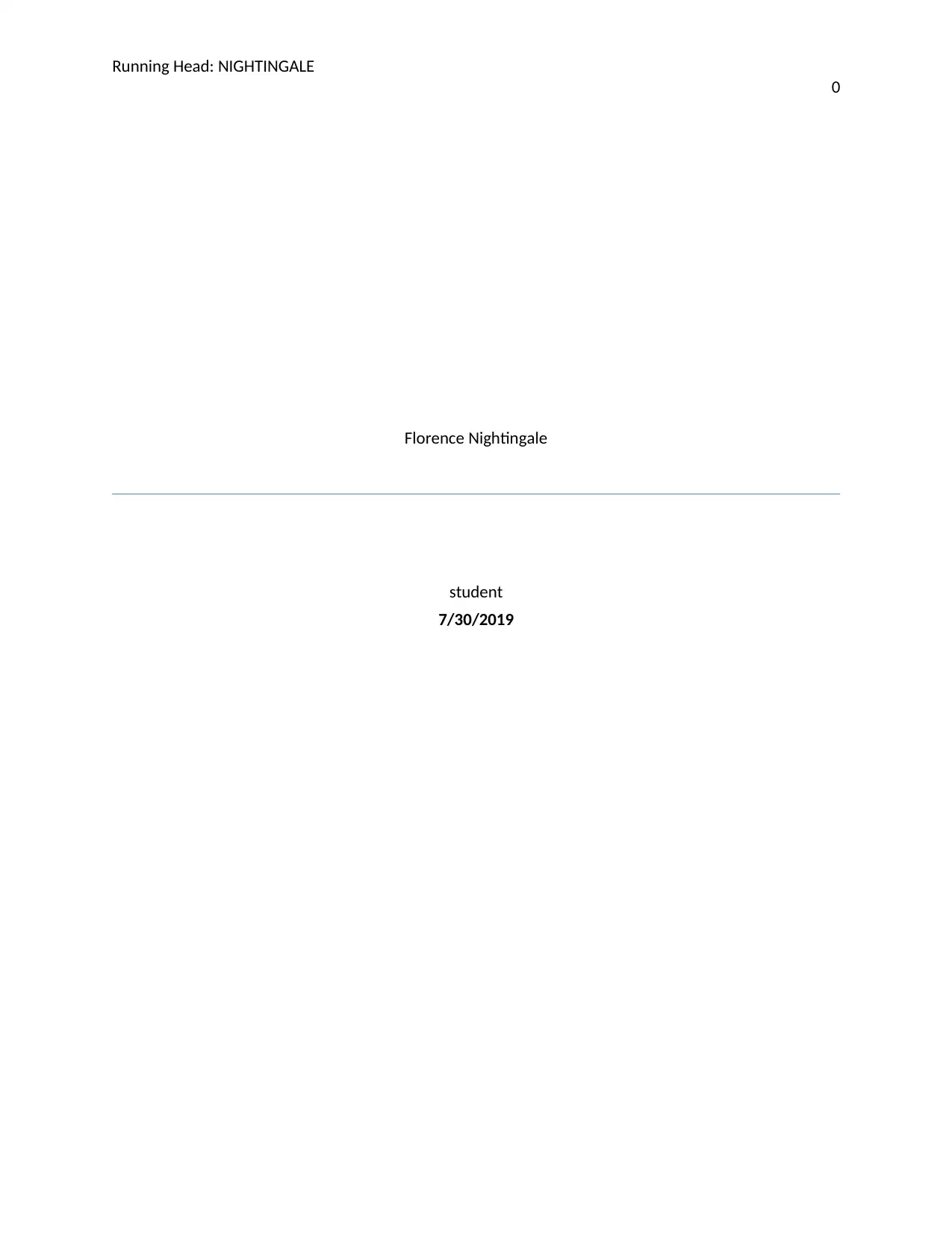
Running Head: NIGHTINGALE
0
Florence Nightingale
student
7/30/2019
0
Florence Nightingale
student
7/30/2019
Secure Best Marks with AI Grader
Need help grading? Try our AI Grader for instant feedback on your assignments.
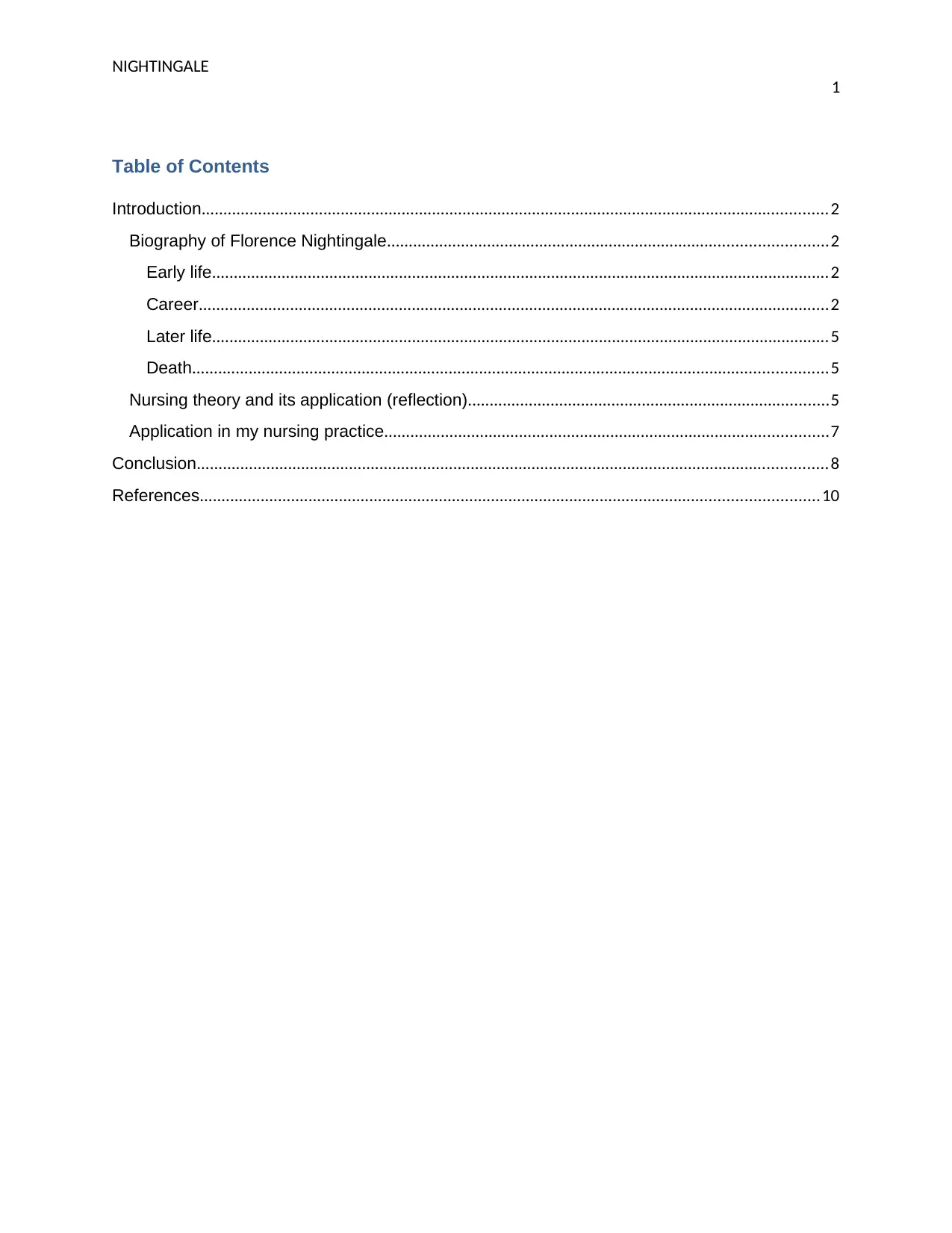
NIGHTINGALE
1
Table of Contents
Introduction................................................................................................................................................2
Biography of Florence Nightingale.....................................................................................................2
Early life..............................................................................................................................................2
Career.................................................................................................................................................2
Later life..............................................................................................................................................5
Death..................................................................................................................................................5
Nursing theory and its application (reflection)...................................................................................5
Application in my nursing practice......................................................................................................7
Conclusion.................................................................................................................................................8
References..............................................................................................................................................10
1
Table of Contents
Introduction................................................................................................................................................2
Biography of Florence Nightingale.....................................................................................................2
Early life..............................................................................................................................................2
Career.................................................................................................................................................2
Later life..............................................................................................................................................5
Death..................................................................................................................................................5
Nursing theory and its application (reflection)...................................................................................5
Application in my nursing practice......................................................................................................7
Conclusion.................................................................................................................................................8
References..............................................................................................................................................10
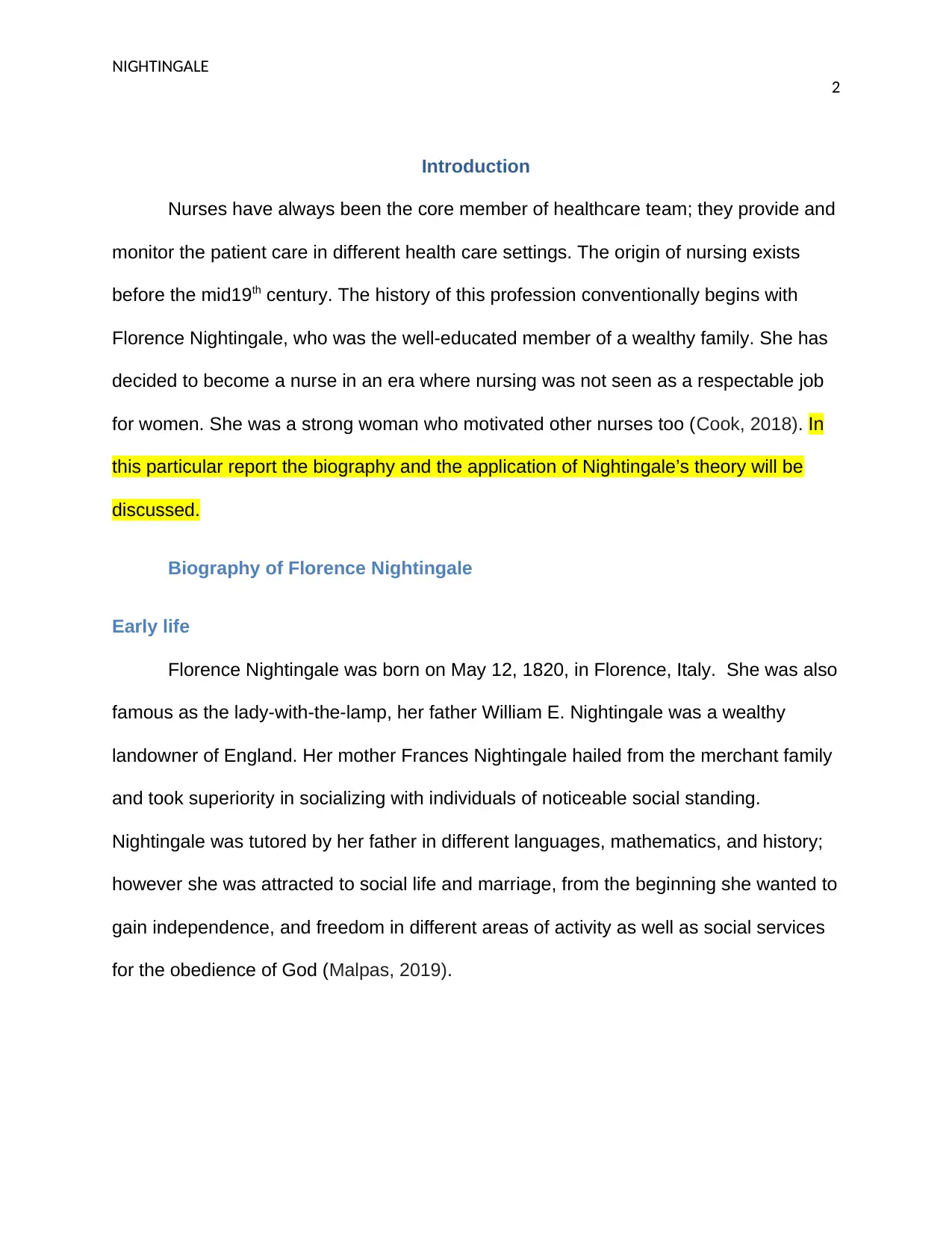
NIGHTINGALE
2
Introduction
Nurses have always been the core member of healthcare team; they provide and
monitor the patient care in different health care settings. The origin of nursing exists
before the mid19th century. The history of this profession conventionally begins with
Florence Nightingale, who was the well-educated member of a wealthy family. She has
decided to become a nurse in an era where nursing was not seen as a respectable job
for women. She was a strong woman who motivated other nurses too (Cook, 2018). In
this particular report the biography and the application of Nightingale’s theory will be
discussed.
Biography of Florence Nightingale
Early life
Florence Nightingale was born on May 12, 1820, in Florence, Italy. She was also
famous as the lady-with-the-lamp, her father William E. Nightingale was a wealthy
landowner of England. Her mother Frances Nightingale hailed from the merchant family
and took superiority in socializing with individuals of noticeable social standing.
Nightingale was tutored by her father in different languages, mathematics, and history;
however she was attracted to social life and marriage, from the beginning she wanted to
gain independence, and freedom in different areas of activity as well as social services
for the obedience of God (Malpas, 2019).
2
Introduction
Nurses have always been the core member of healthcare team; they provide and
monitor the patient care in different health care settings. The origin of nursing exists
before the mid19th century. The history of this profession conventionally begins with
Florence Nightingale, who was the well-educated member of a wealthy family. She has
decided to become a nurse in an era where nursing was not seen as a respectable job
for women. She was a strong woman who motivated other nurses too (Cook, 2018). In
this particular report the biography and the application of Nightingale’s theory will be
discussed.
Biography of Florence Nightingale
Early life
Florence Nightingale was born on May 12, 1820, in Florence, Italy. She was also
famous as the lady-with-the-lamp, her father William E. Nightingale was a wealthy
landowner of England. Her mother Frances Nightingale hailed from the merchant family
and took superiority in socializing with individuals of noticeable social standing.
Nightingale was tutored by her father in different languages, mathematics, and history;
however she was attracted to social life and marriage, from the beginning she wanted to
gain independence, and freedom in different areas of activity as well as social services
for the obedience of God (Malpas, 2019).
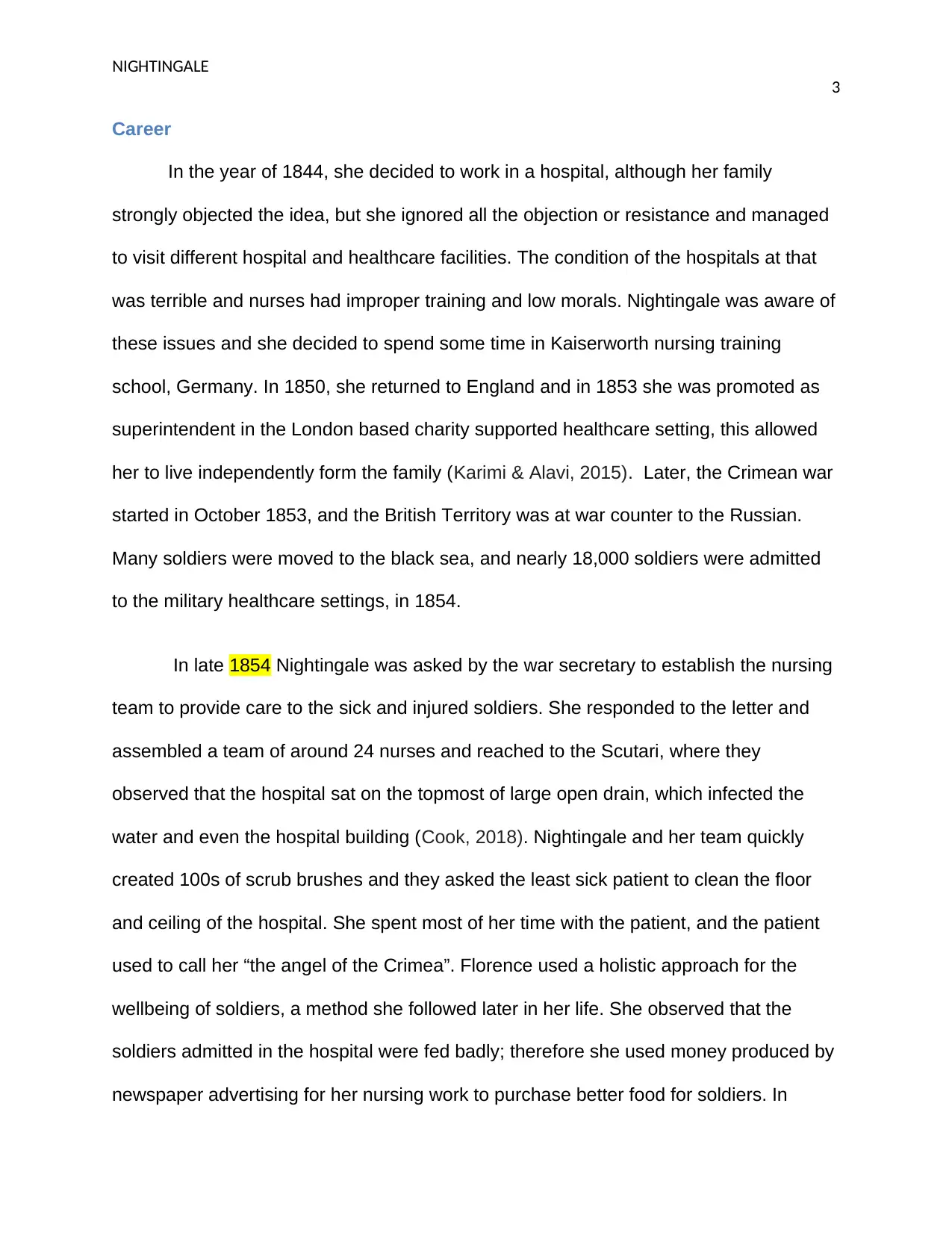
NIGHTINGALE
3
Career
In the year of 1844, she decided to work in a hospital, although her family
strongly objected the idea, but she ignored all the objection or resistance and managed
to visit different hospital and healthcare facilities. The condition of the hospitals at that
was terrible and nurses had improper training and low morals. Nightingale was aware of
these issues and she decided to spend some time in Kaiserworth nursing training
school, Germany. In 1850, she returned to England and in 1853 she was promoted as
superintendent in the London based charity supported healthcare setting, this allowed
her to live independently form the family (Karimi & Alavi, 2015). Later, the Crimean war
started in October 1853, and the British Territory was at war counter to the Russian.
Many soldiers were moved to the black sea, and nearly 18,000 soldiers were admitted
to the military healthcare settings, in 1854.
In late 1854 Nightingale was asked by the war secretary to establish the nursing
team to provide care to the sick and injured soldiers. She responded to the letter and
assembled a team of around 24 nurses and reached to the Scutari, where they
observed that the hospital sat on the topmost of large open drain, which infected the
water and even the hospital building (Cook, 2018). Nightingale and her team quickly
created 100s of scrub brushes and they asked the least sick patient to clean the floor
and ceiling of the hospital. She spent most of her time with the patient, and the patient
used to call her “the angel of the Crimea”. Florence used a holistic approach for the
wellbeing of soldiers, a method she followed later in her life. She observed that the
soldiers admitted in the hospital were fed badly; therefore she used money produced by
newspaper advertising for her nursing work to purchase better food for soldiers. In
3
Career
In the year of 1844, she decided to work in a hospital, although her family
strongly objected the idea, but she ignored all the objection or resistance and managed
to visit different hospital and healthcare facilities. The condition of the hospitals at that
was terrible and nurses had improper training and low morals. Nightingale was aware of
these issues and she decided to spend some time in Kaiserworth nursing training
school, Germany. In 1850, she returned to England and in 1853 she was promoted as
superintendent in the London based charity supported healthcare setting, this allowed
her to live independently form the family (Karimi & Alavi, 2015). Later, the Crimean war
started in October 1853, and the British Territory was at war counter to the Russian.
Many soldiers were moved to the black sea, and nearly 18,000 soldiers were admitted
to the military healthcare settings, in 1854.
In late 1854 Nightingale was asked by the war secretary to establish the nursing
team to provide care to the sick and injured soldiers. She responded to the letter and
assembled a team of around 24 nurses and reached to the Scutari, where they
observed that the hospital sat on the topmost of large open drain, which infected the
water and even the hospital building (Cook, 2018). Nightingale and her team quickly
created 100s of scrub brushes and they asked the least sick patient to clean the floor
and ceiling of the hospital. She spent most of her time with the patient, and the patient
used to call her “the angel of the Crimea”. Florence used a holistic approach for the
wellbeing of soldiers, a method she followed later in her life. She observed that the
soldiers admitted in the hospital were fed badly; therefore she used money produced by
newspaper advertising for her nursing work to purchase better food for soldiers. In
Secure Best Marks with AI Grader
Need help grading? Try our AI Grader for instant feedback on your assignments.
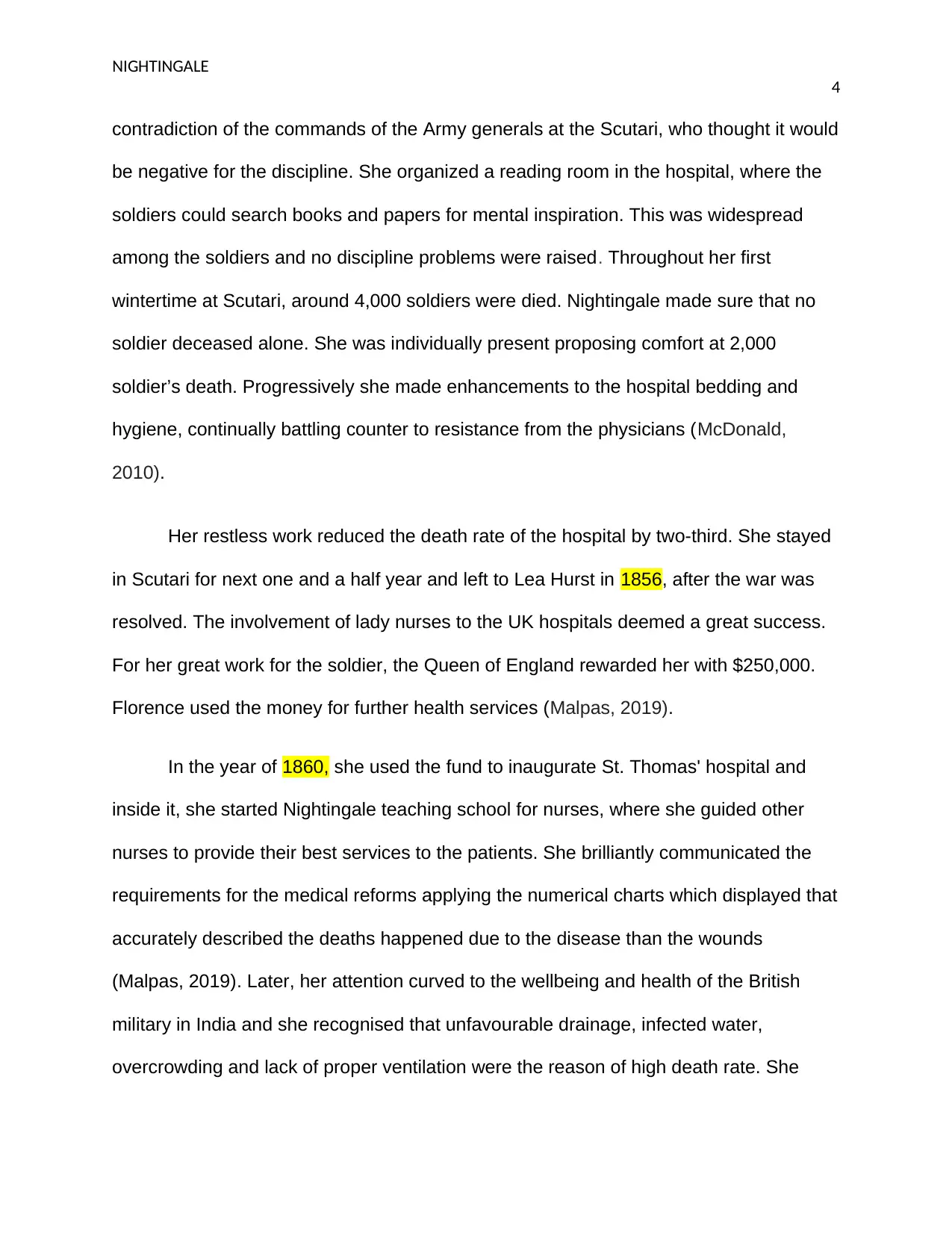
NIGHTINGALE
4
contradiction of the commands of the Army generals at the Scutari, who thought it would
be negative for the discipline. She organized a reading room in the hospital, where the
soldiers could search books and papers for mental inspiration. This was widespread
among the soldiers and no discipline problems were raised. Throughout her first
wintertime at Scutari, around 4,000 soldiers were died. Nightingale made sure that no
soldier deceased alone. She was individually present proposing comfort at 2,000
soldier’s death. Progressively she made enhancements to the hospital bedding and
hygiene, continually battling counter to resistance from the physicians (McDonald,
2010).
Her restless work reduced the death rate of the hospital by two-third. She stayed
in Scutari for next one and a half year and left to Lea Hurst in 1856, after the war was
resolved. The involvement of lady nurses to the UK hospitals deemed a great success.
For her great work for the soldier, the Queen of England rewarded her with $250,000.
Florence used the money for further health services (Malpas, 2019).
In the year of 1860, she used the fund to inaugurate St. Thomas' hospital and
inside it, she started Nightingale teaching school for nurses, where she guided other
nurses to provide their best services to the patients. She brilliantly communicated the
requirements for the medical reforms applying the numerical charts which displayed that
accurately described the deaths happened due to the disease than the wounds
(Malpas, 2019). Later, her attention curved to the wellbeing and health of the British
military in India and she recognised that unfavourable drainage, infected water,
overcrowding and lack of proper ventilation were the reason of high death rate. She
4
contradiction of the commands of the Army generals at the Scutari, who thought it would
be negative for the discipline. She organized a reading room in the hospital, where the
soldiers could search books and papers for mental inspiration. This was widespread
among the soldiers and no discipline problems were raised. Throughout her first
wintertime at Scutari, around 4,000 soldiers were died. Nightingale made sure that no
soldier deceased alone. She was individually present proposing comfort at 2,000
soldier’s death. Progressively she made enhancements to the hospital bedding and
hygiene, continually battling counter to resistance from the physicians (McDonald,
2010).
Her restless work reduced the death rate of the hospital by two-third. She stayed
in Scutari for next one and a half year and left to Lea Hurst in 1856, after the war was
resolved. The involvement of lady nurses to the UK hospitals deemed a great success.
For her great work for the soldier, the Queen of England rewarded her with $250,000.
Florence used the money for further health services (Malpas, 2019).
In the year of 1860, she used the fund to inaugurate St. Thomas' hospital and
inside it, she started Nightingale teaching school for nurses, where she guided other
nurses to provide their best services to the patients. She brilliantly communicated the
requirements for the medical reforms applying the numerical charts which displayed that
accurately described the deaths happened due to the disease than the wounds
(Malpas, 2019). Later, her attention curved to the wellbeing and health of the British
military in India and she recognised that unfavourable drainage, infected water,
overcrowding and lack of proper ventilation were the reason of high death rate. She
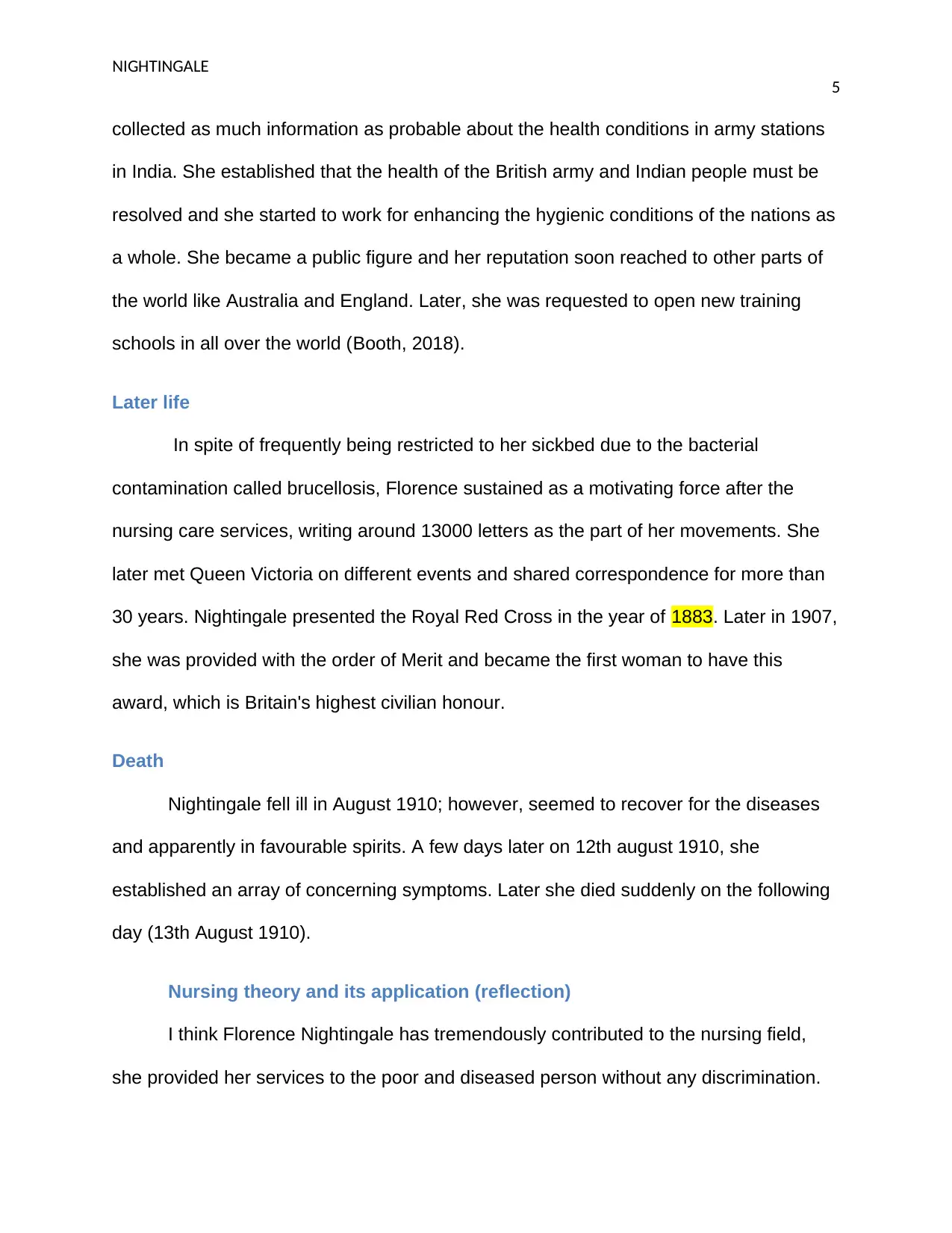
NIGHTINGALE
5
collected as much information as probable about the health conditions in army stations
in India. She established that the health of the British army and Indian people must be
resolved and she started to work for enhancing the hygienic conditions of the nations as
a whole. She became a public figure and her reputation soon reached to other parts of
the world like Australia and England. Later, she was requested to open new training
schools in all over the world (Booth, 2018).
Later life
In spite of frequently being restricted to her sickbed due to the bacterial
contamination called brucellosis, Florence sustained as a motivating force after the
nursing care services, writing around 13000 letters as the part of her movements. She
later met Queen Victoria on different events and shared correspondence for more than
30 years. Nightingale presented the Royal Red Cross in the year of 1883. Later in 1907,
she was provided with the order of Merit and became the first woman to have this
award, which is Britain's highest civilian honour.
Death
Nightingale fell ill in August 1910; however, seemed to recover for the diseases
and apparently in favourable spirits. A few days later on 12th august 1910, she
established an array of concerning symptoms. Later she died suddenly on the following
day (13th August 1910).
Nursing theory and its application (reflection)
I think Florence Nightingale has tremendously contributed to the nursing field,
she provided her services to the poor and diseased person without any discrimination.
5
collected as much information as probable about the health conditions in army stations
in India. She established that the health of the British army and Indian people must be
resolved and she started to work for enhancing the hygienic conditions of the nations as
a whole. She became a public figure and her reputation soon reached to other parts of
the world like Australia and England. Later, she was requested to open new training
schools in all over the world (Booth, 2018).
Later life
In spite of frequently being restricted to her sickbed due to the bacterial
contamination called brucellosis, Florence sustained as a motivating force after the
nursing care services, writing around 13000 letters as the part of her movements. She
later met Queen Victoria on different events and shared correspondence for more than
30 years. Nightingale presented the Royal Red Cross in the year of 1883. Later in 1907,
she was provided with the order of Merit and became the first woman to have this
award, which is Britain's highest civilian honour.
Death
Nightingale fell ill in August 1910; however, seemed to recover for the diseases
and apparently in favourable spirits. A few days later on 12th august 1910, she
established an array of concerning symptoms. Later she died suddenly on the following
day (13th August 1910).
Nursing theory and its application (reflection)
I think Florence Nightingale has tremendously contributed to the nursing field,
she provided her services to the poor and diseased person without any discrimination.
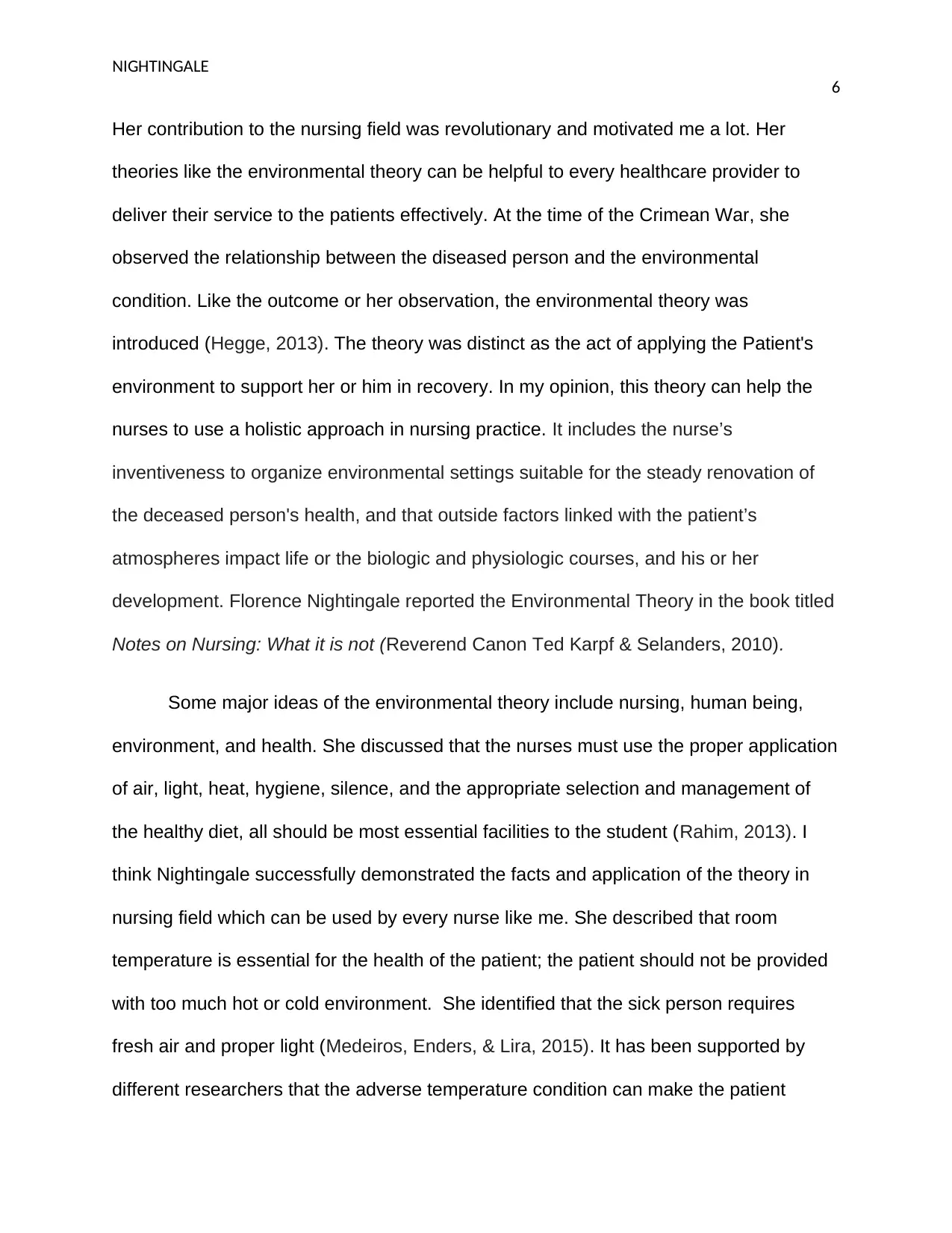
NIGHTINGALE
6
Her contribution to the nursing field was revolutionary and motivated me a lot. Her
theories like the environmental theory can be helpful to every healthcare provider to
deliver their service to the patients effectively. At the time of the Crimean War, she
observed the relationship between the diseased person and the environmental
condition. Like the outcome or her observation, the environmental theory was
introduced (Hegge, 2013). The theory was distinct as the act of applying the Patient's
environment to support her or him in recovery. In my opinion, this theory can help the
nurses to use a holistic approach in nursing practice. It includes the nurse’s
inventiveness to organize environmental settings suitable for the steady renovation of
the deceased person's health, and that outside factors linked with the patient’s
atmospheres impact life or the biologic and physiologic courses, and his or her
development. Florence Nightingale reported the Environmental Theory in the book titled
Notes on Nursing: What it is not (Reverend Canon Ted Karpf & Selanders, 2010).
Some major ideas of the environmental theory include nursing, human being,
environment, and health. She discussed that the nurses must use the proper application
of air, light, heat, hygiene, silence, and the appropriate selection and management of
the healthy diet, all should be most essential facilities to the student (Rahim, 2013). I
think Nightingale successfully demonstrated the facts and application of the theory in
nursing field which can be used by every nurse like me. She described that room
temperature is essential for the health of the patient; the patient should not be provided
with too much hot or cold environment. She identified that the sick person requires
fresh air and proper light (Medeiros, Enders, & Lira, 2015). It has been supported by
different researchers that the adverse temperature condition can make the patient
6
Her contribution to the nursing field was revolutionary and motivated me a lot. Her
theories like the environmental theory can be helpful to every healthcare provider to
deliver their service to the patients effectively. At the time of the Crimean War, she
observed the relationship between the diseased person and the environmental
condition. Like the outcome or her observation, the environmental theory was
introduced (Hegge, 2013). The theory was distinct as the act of applying the Patient's
environment to support her or him in recovery. In my opinion, this theory can help the
nurses to use a holistic approach in nursing practice. It includes the nurse’s
inventiveness to organize environmental settings suitable for the steady renovation of
the deceased person's health, and that outside factors linked with the patient’s
atmospheres impact life or the biologic and physiologic courses, and his or her
development. Florence Nightingale reported the Environmental Theory in the book titled
Notes on Nursing: What it is not (Reverend Canon Ted Karpf & Selanders, 2010).
Some major ideas of the environmental theory include nursing, human being,
environment, and health. She discussed that the nurses must use the proper application
of air, light, heat, hygiene, silence, and the appropriate selection and management of
the healthy diet, all should be most essential facilities to the student (Rahim, 2013). I
think Nightingale successfully demonstrated the facts and application of the theory in
nursing field which can be used by every nurse like me. She described that room
temperature is essential for the health of the patient; the patient should not be provided
with too much hot or cold environment. She identified that the sick person requires
fresh air and proper light (Medeiros, Enders, & Lira, 2015). It has been supported by
different researchers that the adverse temperature condition can make the patient
Paraphrase This Document
Need a fresh take? Get an instant paraphrase of this document with our AI Paraphraser
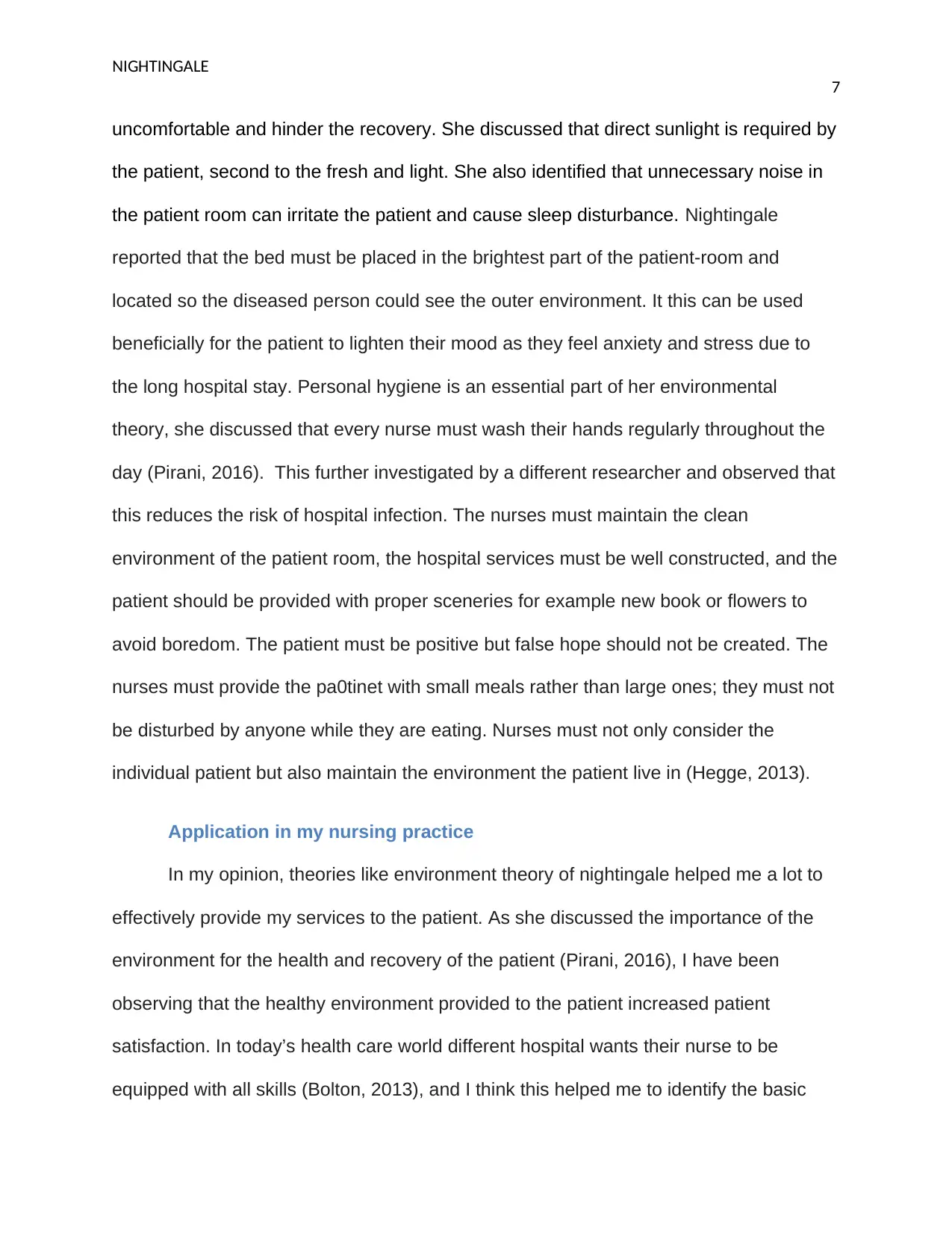
NIGHTINGALE
7
uncomfortable and hinder the recovery. She discussed that direct sunlight is required by
the patient, second to the fresh and light. She also identified that unnecessary noise in
the patient room can irritate the patient and cause sleep disturbance. Nightingale
reported that the bed must be placed in the brightest part of the patient-room and
located so the diseased person could see the outer environment. It this can be used
beneficially for the patient to lighten their mood as they feel anxiety and stress due to
the long hospital stay. Personal hygiene is an essential part of her environmental
theory, she discussed that every nurse must wash their hands regularly throughout the
day (Pirani, 2016). This further investigated by a different researcher and observed that
this reduces the risk of hospital infection. The nurses must maintain the clean
environment of the patient room, the hospital services must be well constructed, and the
patient should be provided with proper sceneries for example new book or flowers to
avoid boredom. The patient must be positive but false hope should not be created. The
nurses must provide the pa0tinet with small meals rather than large ones; they must not
be disturbed by anyone while they are eating. Nurses must not only consider the
individual patient but also maintain the environment the patient live in (Hegge, 2013).
Application in my nursing practice
In my opinion, theories like environment theory of nightingale helped me a lot to
effectively provide my services to the patient. As she discussed the importance of the
environment for the health and recovery of the patient (Pirani, 2016), I have been
observing that the healthy environment provided to the patient increased patient
satisfaction. In today’s health care world different hospital wants their nurse to be
equipped with all skills (Bolton, 2013), and I think this helped me to identify the basic
7
uncomfortable and hinder the recovery. She discussed that direct sunlight is required by
the patient, second to the fresh and light. She also identified that unnecessary noise in
the patient room can irritate the patient and cause sleep disturbance. Nightingale
reported that the bed must be placed in the brightest part of the patient-room and
located so the diseased person could see the outer environment. It this can be used
beneficially for the patient to lighten their mood as they feel anxiety and stress due to
the long hospital stay. Personal hygiene is an essential part of her environmental
theory, she discussed that every nurse must wash their hands regularly throughout the
day (Pirani, 2016). This further investigated by a different researcher and observed that
this reduces the risk of hospital infection. The nurses must maintain the clean
environment of the patient room, the hospital services must be well constructed, and the
patient should be provided with proper sceneries for example new book or flowers to
avoid boredom. The patient must be positive but false hope should not be created. The
nurses must provide the pa0tinet with small meals rather than large ones; they must not
be disturbed by anyone while they are eating. Nurses must not only consider the
individual patient but also maintain the environment the patient live in (Hegge, 2013).
Application in my nursing practice
In my opinion, theories like environment theory of nightingale helped me a lot to
effectively provide my services to the patient. As she discussed the importance of the
environment for the health and recovery of the patient (Pirani, 2016), I have been
observing that the healthy environment provided to the patient increased patient
satisfaction. In today’s health care world different hospital wants their nurse to be
equipped with all skills (Bolton, 2013), and I think this helped me to identify the basic
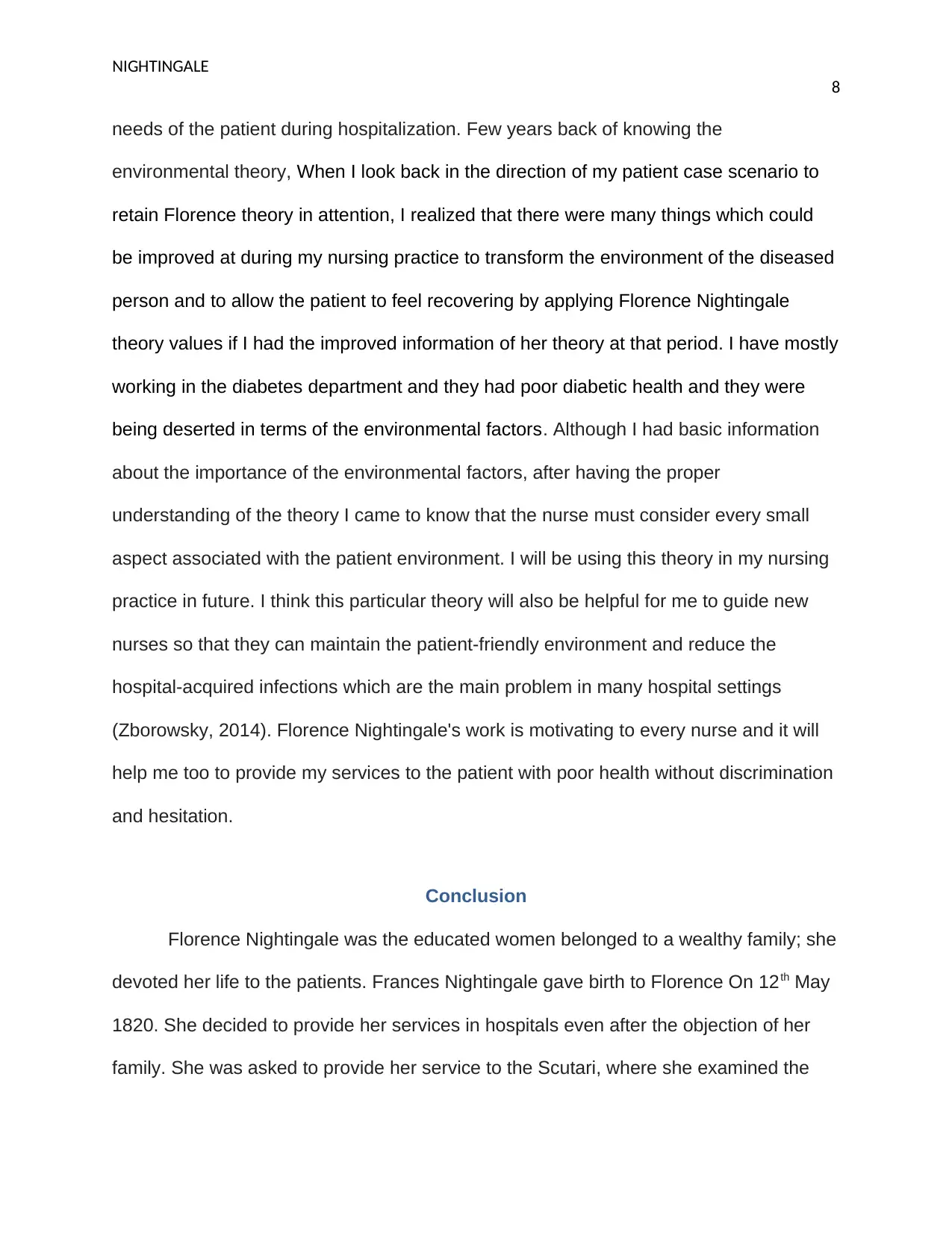
NIGHTINGALE
8
needs of the patient during hospitalization. Few years back of knowing the
environmental theory, When I look back in the direction of my patient case scenario to
retain Florence theory in attention, I realized that there were many things which could
be improved at during my nursing practice to transform the environment of the diseased
person and to allow the patient to feel recovering by applying Florence Nightingale
theory values if I had the improved information of her theory at that period. I have mostly
working in the diabetes department and they had poor diabetic health and they were
being deserted in terms of the environmental factors. Although I had basic information
about the importance of the environmental factors, after having the proper
understanding of the theory I came to know that the nurse must consider every small
aspect associated with the patient environment. I will be using this theory in my nursing
practice in future. I think this particular theory will also be helpful for me to guide new
nurses so that they can maintain the patient-friendly environment and reduce the
hospital-acquired infections which are the main problem in many hospital settings
(Zborowsky, 2014). Florence Nightingale's work is motivating to every nurse and it will
help me too to provide my services to the patient with poor health without discrimination
and hesitation.
Conclusion
Florence Nightingale was the educated women belonged to a wealthy family; she
devoted her life to the patients. Frances Nightingale gave birth to Florence On 12th May
1820. She decided to provide her services in hospitals even after the objection of her
family. She was asked to provide her service to the Scutari, where she examined the
8
needs of the patient during hospitalization. Few years back of knowing the
environmental theory, When I look back in the direction of my patient case scenario to
retain Florence theory in attention, I realized that there were many things which could
be improved at during my nursing practice to transform the environment of the diseased
person and to allow the patient to feel recovering by applying Florence Nightingale
theory values if I had the improved information of her theory at that period. I have mostly
working in the diabetes department and they had poor diabetic health and they were
being deserted in terms of the environmental factors. Although I had basic information
about the importance of the environmental factors, after having the proper
understanding of the theory I came to know that the nurse must consider every small
aspect associated with the patient environment. I will be using this theory in my nursing
practice in future. I think this particular theory will also be helpful for me to guide new
nurses so that they can maintain the patient-friendly environment and reduce the
hospital-acquired infections which are the main problem in many hospital settings
(Zborowsky, 2014). Florence Nightingale's work is motivating to every nurse and it will
help me too to provide my services to the patient with poor health without discrimination
and hesitation.
Conclusion
Florence Nightingale was the educated women belonged to a wealthy family; she
devoted her life to the patients. Frances Nightingale gave birth to Florence On 12th May
1820. She decided to provide her services in hospitals even after the objection of her
family. She was asked to provide her service to the Scutari, where she examined the
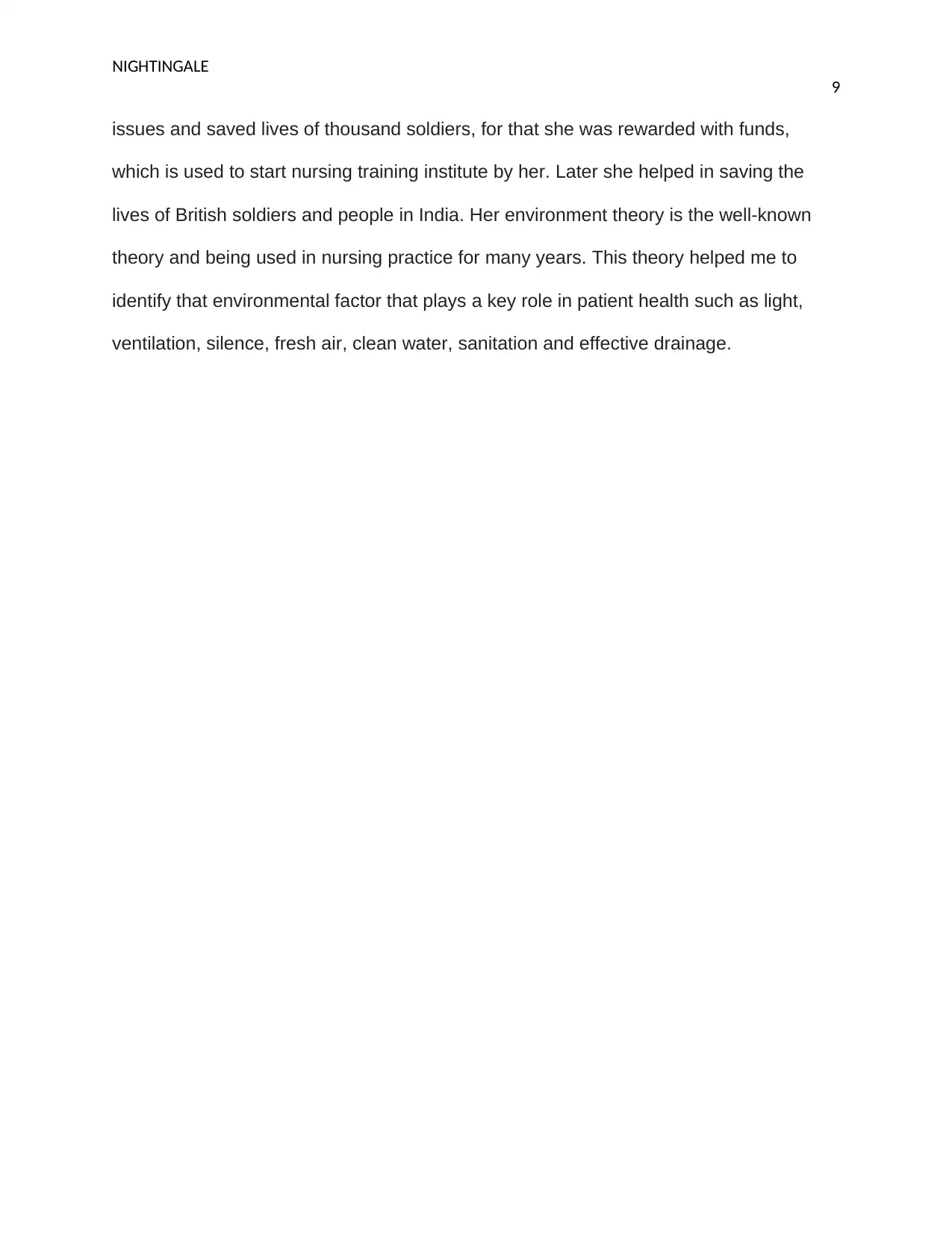
NIGHTINGALE
9
issues and saved lives of thousand soldiers, for that she was rewarded with funds,
which is used to start nursing training institute by her. Later she helped in saving the
lives of British soldiers and people in India. Her environment theory is the well-known
theory and being used in nursing practice for many years. This theory helped me to
identify that environmental factor that plays a key role in patient health such as light,
ventilation, silence, fresh air, clean water, sanitation and effective drainage.
9
issues and saved lives of thousand soldiers, for that she was rewarded with funds,
which is used to start nursing training institute by her. Later she helped in saving the
lives of British soldiers and people in India. Her environment theory is the well-known
theory and being used in nursing practice for many years. This theory helped me to
identify that environmental factor that plays a key role in patient health such as light,
ventilation, silence, fresh air, clean water, sanitation and effective drainage.
Secure Best Marks with AI Grader
Need help grading? Try our AI Grader for instant feedback on your assignments.
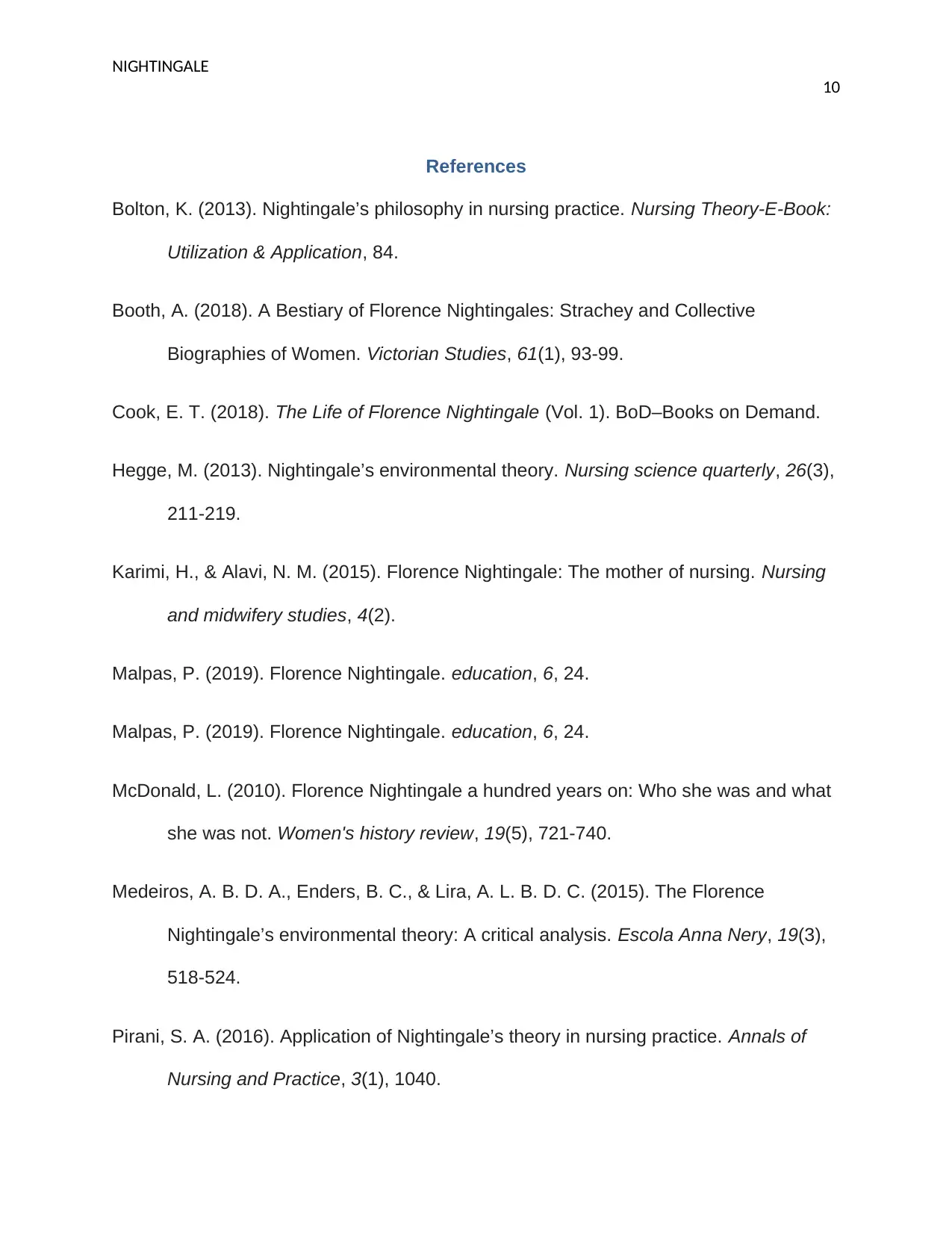
NIGHTINGALE
10
References
Bolton, K. (2013). Nightingale’s philosophy in nursing practice. Nursing Theory-E-Book:
Utilization & Application, 84.
Booth, A. (2018). A Bestiary of Florence Nightingales: Strachey and Collective
Biographies of Women. Victorian Studies, 61(1), 93-99.
Cook, E. T. (2018). The Life of Florence Nightingale (Vol. 1). BoD–Books on Demand.
Hegge, M. (2013). Nightingale’s environmental theory. Nursing science quarterly, 26(3),
211-219.
Karimi, H., & Alavi, N. M. (2015). Florence Nightingale: The mother of nursing. Nursing
and midwifery studies, 4(2).
Malpas, P. (2019). Florence Nightingale. education, 6, 24.
Malpas, P. (2019). Florence Nightingale. education, 6, 24.
McDonald, L. (2010). Florence Nightingale a hundred years on: Who she was and what
she was not. Women's history review, 19(5), 721-740.
Medeiros, A. B. D. A., Enders, B. C., & Lira, A. L. B. D. C. (2015). The Florence
Nightingale’s environmental theory: A critical analysis. Escola Anna Nery, 19(3),
518-524.
Pirani, S. A. (2016). Application of Nightingale’s theory in nursing practice. Annals of
Nursing and Practice, 3(1), 1040.
10
References
Bolton, K. (2013). Nightingale’s philosophy in nursing practice. Nursing Theory-E-Book:
Utilization & Application, 84.
Booth, A. (2018). A Bestiary of Florence Nightingales: Strachey and Collective
Biographies of Women. Victorian Studies, 61(1), 93-99.
Cook, E. T. (2018). The Life of Florence Nightingale (Vol. 1). BoD–Books on Demand.
Hegge, M. (2013). Nightingale’s environmental theory. Nursing science quarterly, 26(3),
211-219.
Karimi, H., & Alavi, N. M. (2015). Florence Nightingale: The mother of nursing. Nursing
and midwifery studies, 4(2).
Malpas, P. (2019). Florence Nightingale. education, 6, 24.
Malpas, P. (2019). Florence Nightingale. education, 6, 24.
McDonald, L. (2010). Florence Nightingale a hundred years on: Who she was and what
she was not. Women's history review, 19(5), 721-740.
Medeiros, A. B. D. A., Enders, B. C., & Lira, A. L. B. D. C. (2015). The Florence
Nightingale’s environmental theory: A critical analysis. Escola Anna Nery, 19(3),
518-524.
Pirani, S. A. (2016). Application of Nightingale’s theory in nursing practice. Annals of
Nursing and Practice, 3(1), 1040.
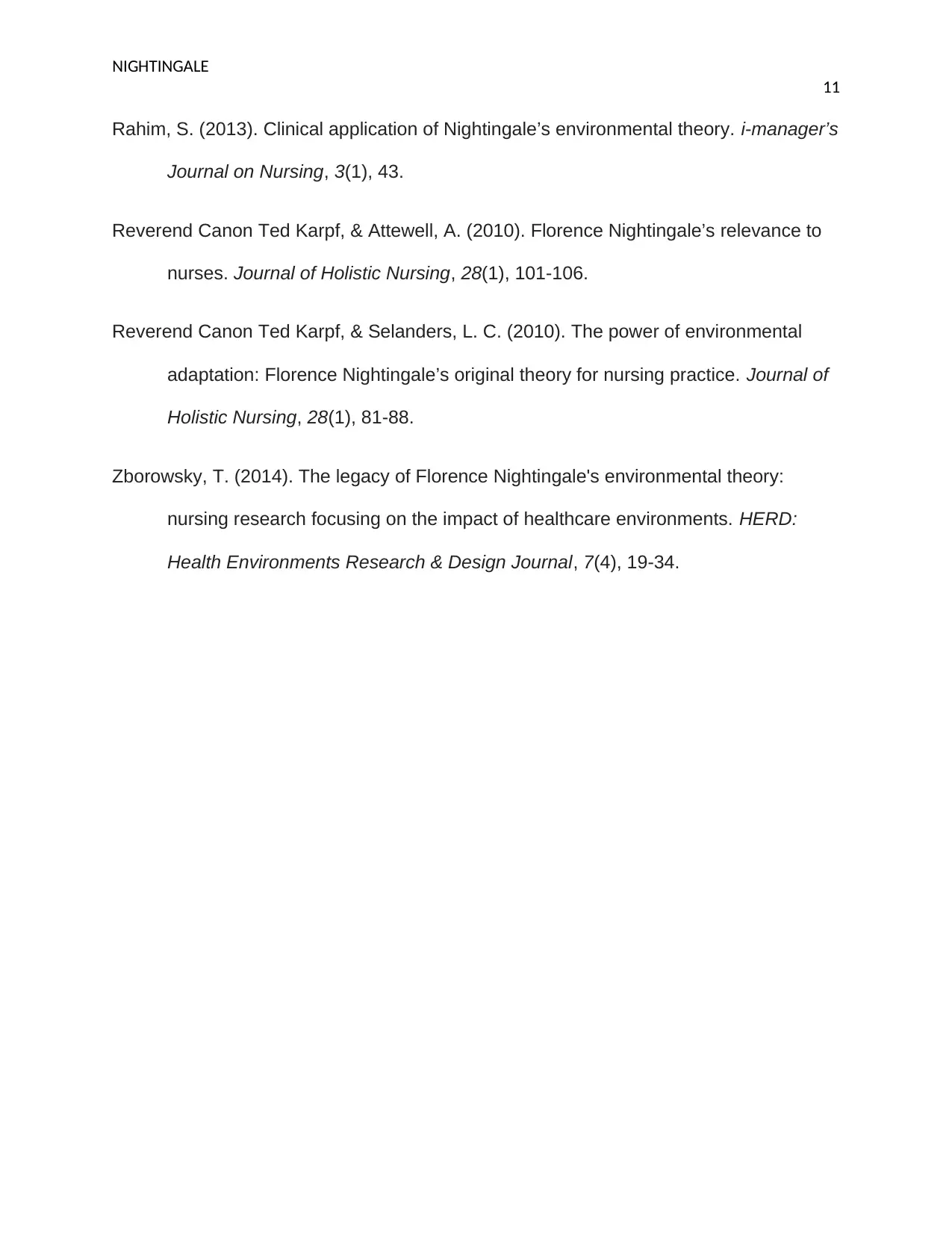
NIGHTINGALE
11
Rahim, S. (2013). Clinical application of Nightingale’s environmental theory. i-manager’s
Journal on Nursing, 3(1), 43.
Reverend Canon Ted Karpf, & Attewell, A. (2010). Florence Nightingale’s relevance to
nurses. Journal of Holistic Nursing, 28(1), 101-106.
Reverend Canon Ted Karpf, & Selanders, L. C. (2010). The power of environmental
adaptation: Florence Nightingale’s original theory for nursing practice. Journal of
Holistic Nursing, 28(1), 81-88.
Zborowsky, T. (2014). The legacy of Florence Nightingale's environmental theory:
nursing research focusing on the impact of healthcare environments. HERD:
Health Environments Research & Design Journal, 7(4), 19-34.
11
Rahim, S. (2013). Clinical application of Nightingale’s environmental theory. i-manager’s
Journal on Nursing, 3(1), 43.
Reverend Canon Ted Karpf, & Attewell, A. (2010). Florence Nightingale’s relevance to
nurses. Journal of Holistic Nursing, 28(1), 101-106.
Reverend Canon Ted Karpf, & Selanders, L. C. (2010). The power of environmental
adaptation: Florence Nightingale’s original theory for nursing practice. Journal of
Holistic Nursing, 28(1), 81-88.
Zborowsky, T. (2014). The legacy of Florence Nightingale's environmental theory:
nursing research focusing on the impact of healthcare environments. HERD:
Health Environments Research & Design Journal, 7(4), 19-34.
1 out of 12
Related Documents
Your All-in-One AI-Powered Toolkit for Academic Success.
+13062052269
info@desklib.com
Available 24*7 on WhatsApp / Email
![[object Object]](/_next/static/media/star-bottom.7253800d.svg)
Unlock your academic potential
© 2024 | Zucol Services PVT LTD | All rights reserved.





